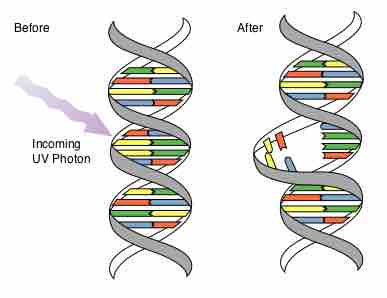Ultraviolet Light
Ultraviolet (UV) light is electromagnetic radiation with a wavelength shorter than that of visible light, but longer than X-rays, that is, in the range 10 nm to 400 nm, corresponding to photon energies from 3 eV to 124 eV (1 eV = 1.6e-19 J; EM radiation with frequencies higher than those of visible light are often expressed in terms of energy rather than frequency). It is so-named because the spectrum consists of electromagnetic waves with frequencies higher than those that humans identify as the color violet . These frequencies are invisible to humans, but visible to a number of insects and birds.
Electromagnetic Spectrum
The electromagnetic spectrum, showing the major categories of electromagnetic waves. The range of frequencies and wavelengths is remarkable. The dividing line between some categories is distinct, whereas other categories overlap. Microwaves encompass the high frequency portion of the radio section of the EM spectrum.
UV light is found in sunlight (where it constitutes about 10% of the energy in vacuum) and is emitted by electric arcs and specialized lights such as black lights. It can cause chemical reactions, and causes many substances to glow or fluoresce. Most ultraviolet is classified as non-ionizing radiation. The higher energies of the ultraviolet spectrum from wavelengths about 10 nm to 120 nm ('extreme' ultraviolet) are ionizing, but this type of ultraviolet in sunlight is blocked by normal molecular oxygen (O2) in air, and does not reach the ground. However, the entire spectrum of ultraviolet radiation has some of the biological features of ionizing radiation, in doing far more damage to many molecules in biological systems than is accounted for by simple heating effects (an example is sunburn). These properties derive from the ultraviolet photon's power to alter chemical bonds in molecules, even without having enough energy to ionize atoms.
Although ultraviolet radiation is invisible to the human eye, most people are aware of the effects of UV on the skin, called suntan and sunburn . In addition to short wave UV blocked by oxygen, a great deal (>97%) of mid-range ultraviolet (almost all UV above 280 nm and most up to 315 nm) is blocked by the ozone layer, and like ionizing short wave UV, would cause much damage to living organisms if it penetrated the atmosphere. After atmospheric filtering, only about 3% of the total energy of sunlight at the zenith is ultraviolet, and this fraction decreases at other sun angles. Much of it is near-ultraviolet that does not cause sunburn, but is still capable of causing long term skin damage and cancer. An even smaller fraction of ultraviolet that reaches the ground is responsible for sunburn and also the formation of vitamin D (peak production occurring between 295 and 297 nm) in all organisms that make this vitamin (including humans). The UV spectrum thus has many effects, both beneficial and damaging, to human health.

Atmospheric Transmittance
This is a plot of Earth's atmospheric opacity (opposite of transmittance) to various wavelengths of electromagnetic radiation, including visible light. Visible light passes relatively unimpeded through the atmosphere in the "optical window." Most UV wavelengths are absorbed by oxygen and ozone in Earth's atmosphere. Observations of astronomical UV sources must be done from space.
Subcategories of UV Light
Solar UV radiation is commonly subdivided into three regions: UV-A (320–400 nm), UV-B (290–320 nm), and UV-C (220–290 nm), ranked from long to shorter wavelengths (from smaller to larger energies). Most UV-B and all UV-C is absorbed by ozone (O3) molecules in the upper atmosphere. Consequently, 99% of the solar UV radiation reaching the Earth's surface is UV-A.
There are other schemes for dividing UV into different categories, another common one is: near-ultraviolet (NUV - 300-400 nm), middle ultraviolet (MUV - 200-300 nm), far ultraviolet (FUV - 200-122 nm), and extreme ultraviolet (EUV- 121-10 nm).
Harmful Effects
An overexposure to UVB radiation can cause sunburn and some forms of skin cancer . In humans, prolonged exposure to solar UV radiation may result in acute and chronic health effects on the skin, eye, and immune system. Moreover, UVC can cause adverse effects that can variously be mutagenic or carcinogenic.

DNA UV Mutation
Ultraviolet photons harm the DNA molecules of living organisms in different ways. In one common damage event, adjacent thymine bases bond with each other, instead of across the "ladder. " This "thymine dimer" makes a bulge, and the distorted DNA molecule does not function properly.
The International Agency for Research on Cancer of the World Health Organization has classified all categories and wavelengths of ultraviolet radiation as a Group 1 carcinogen. This is the highest level designation for carcinogens and means that "there is enough evidence to conclude that it can cause cancer in humans. "
Beneficial Effects
UVB exposure induces the production of vitamin D in the skin. The majority of positive health effects are related to this vitamin. It has regulatory roles in calcium metabolism (which is vital for normal functioning of the nervous system, as well as for bone growth and maintenance of bone density), immunity, cell proliferation, insulin secretion, and blood pressure.